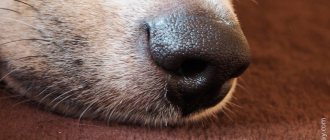General characteristics of the origin of intestinal colic in dogs
As a rule, intestinal colic is most often observed in young dogs and puppies. They can occur due to excessive consumption of food or as a result of adding low-quality products to the diet. In puppies, similar symptoms may appear due to sudden weaning from their mother’s milk.
Intestinal colic can occur as a result of the following diseases:
- Gastritis.
- Lack of enzymes.
- Ulcers in the intestines.
- Cancer.
- Entry of a foreign body into the intestines.
Clinical signs
Spasmodic contractions can cause diarrhea.
- Spasmodic contractions are characterized by suddenness. Up to ten spasms can come and go in one minute. The animal whines loudly, rolls on the ground, twists its whole body into bizarre poses. Less commonly, nausea, vomiting, and diarrhea may occur.
- However, most often pain occurs at those moments when the animal tries to defecate. If spasms occur during the fulfillment of natural needs, this most likely indicates a blockage with stones, which may be located in the kidneys or bladder. But it can also be associated with intussusception - volvulus.
- During attacks, the abdomen enlarges, and upon palpation, significant tension in the abdominal wall is felt. When listening, seething can be heard. The pet cannot eat, turns away from the bowl of food, and breathes rapidly. The pulse is uneven and rapid, which indicates strong excitement.
- During attacks, temperature fluctuations are possible due to the fact that thermoregulation is disrupted in this situation. In such cases, you should not expect everything to go away on its own; you should immediately consult a doctor. Kidney or liver spasms are characterized by severe vomiting, and the vomit will resemble white foam.
- The appetite remains, and pain in the lumbar back is observed, which is expressed by the dog’s nervousness. The dog is constantly circling in place, trying to find a comfortable position to lie down. The abdomen is distended, there may be constipation, but frequent urination is observed.
- If the attacks are the result of the presence of stones, peritonitis, and occur with alarming frequency, the puppy may die as a result of painful shock. There is also a risk of rupture of internal organs if the intensity and strength of the spasms goes off scale. Rupture of internal organs is guaranteed to lead to internal bleeding, and the puppy dies.
First symptoms in dogs
Since all owners love their pets very much and are afraid of losing them, it is imperative to monitor their behavior and nutrition. Animals, like people, can experience pain, and dogs also have a large number of diseases similar to humans. If the dog begins to behave strangely, for example, refuses to eat and whines, then you need to carefully monitor him . If nothing changes, it is recommended to go to the vet.
Self-treatment should be abandoned, since without appropriate education you can only harm your pet.
With intestinal colic, dogs experience bloating. The abdominal cavity is in a tense state all the time and makes gurgling sounds. The dog begins to refuse food, lies on his stomach on the floor and begins to whine. In addition, your heart rate and breathing may increase.
If you do not pay attention to all the above symptoms in a timely manner, then the animal may experience a volvulus, as a result of which the dog may even die. At best, an expensive operation will be required.
Colic in the liver and kidneys manifests itself in the form of white vomit or yellowish foam, but the animal eats food without problems. Also, renal colic can cause the dog to be unable to sit in one place for a long time and constantly changing its position. The main symptoms of colic are that the dog has a bloated abdomen, he goes to the toilet very often, or, on the contrary, cannot empty his bowels normally for a long time.
Causes of intestinal inflammation
The intestinal mucosa faces a variety of impacts, second only to the skin in this regard. At the same time, the protective mechanisms of the intestine are significantly weaker. Enterocolitis in dogs can be associated with a variety of reasons:
- nutritional factors - poor quality food, hot or cold, irregular feeding, presence of irritating and toxic substances in food;
- infectious and invasive causes;
- primary diseases (hepatitis, pneumonia, pancreatitis);
- intestinal defects (blockage, vascular ischemia, tumors);
- pathology of neuroendocrine regulation.
The main etiological factor leading to an inflammatory reaction in the intestines is feeding, or rather errors in it. It has now become widely popular to use ready-made commercial food for dog nutrition - dry, wet canned food. Not every one of these products is suitable for long-term feeding - they are made from low-quality raw materials, and to improve their consumption they are saturated with various flavor enhancers.
A hereditary predisposition to ulcerative colitis has been identified in boxers.
Bacteria and viruses are an essential component of intestinal inflammation. If they did not cause enteritis, they certainly complicated it. Mechanical damage to the intestines and trauma by parasites leads to the development of a gateway for infection. In addition, diseases such as leptospirosis, colibacillosis, pasteurellosis, parvovirus enteritis, and salmonellosis have a direct effect on the intestines. As a result, beneficial microflora is replaced
Mechanism of development of enterocolitis:
- exposure to a pathogenic factor;
- inflammatory response, degenerative processes;
- suppression of gland function and absorption - digestion is disrupted;
- the lack of enzymes increases - fermentation occurs in the intestines;
- the protective function of the intestinal mucosa is suppressed, resistance decreases;
- most of the beneficial microflora is reduced;
- intestinal motor function is impaired;
- decomposition products accumulate - indole, skatole, and the body is poisoned.
Enterocolitis can develop against the background of other diseases. Most intestinal lesions lead to inflammatory reactions: neoplasms, volvulus and pinched loops, vascular infarction. Diseases and systemic non-contagious pathologies contribute - liver cirrhosis and hepatitis, metabolic disorders, pneumonia and bronchitis.
Treatment
Colic is one of those types of diseases that can be quickly cured with timely initiation of therapy . Treatment should begin with careful monitoring of the pet's condition (it is recommended to write down all symptoms). Then you should go to the veterinarian and diagnose the animal’s health. Next, the veterinarian is required to write out detailed instructions on caring for the animal.
If it is not possible to go to a veterinarian, and the dog’s condition worsens, it is necessary to provide him with first aid.
First aid is that the owner must carefully massage his pet's belly and then place a warm heating pad on it. This method is very simple and effective and is guaranteed to improve the dog’s condition, the main thing is not to delay a trip to the doctor.
There is another method of providing first aid to an animal; it consists in giving the dog activated carbon at the rate of 2 tablets per 20 kg of animal weight . If you have analgin on hand, then it is administered intramuscularly, calculating the dose - up to 2 ml per 10-15 kg, diphenhydramine (2 ml) is also suitable.
In the case where injections are contraindicated for a dog, it is recommended to dilute the tablet and administer this solution in the form of a warm enema of about 10 - 15 ml.
If none of the methods helped improve the animal’s condition, then you should immediately go to the veterinary hospital. To confirm the above disease, the doctor must do a stool test for the pet and take blood for biochemistry.
In the case where before the disease the dog ate only cereals, then after the onset of the disease it is necessary to temporarily exclude them from the diet. It is recommended to switch to dry and liquid food. If kidney stones were found during the examination, it is better to remove them. In situations where it is impossible to cure a pet without surgery, you should relieve the animal from stressful situations and reduce the amount of meat and dairy products in the diet.
What to feed your dog: proper diet
A very important question is what to feed a dog with colic, what are the principles of a proper diet, which can prevent the development of colic. How can you help your dog recover from them? It all depends on the nature of the pathology, but general advice can be given.
Important! Immediately after an attack, the dog needs liquid or semi-liquid food, preferably boiled or steamed. In the first two days, exclude all cereals and bread, fermented milk products and potatoes from the diet.
- On the first day, it is advisable to keep the dog on a fasting diet for at least 12 hours, and then give him liquid jelly. Some owners advise using barely sweet, weak tea. You can’t feed anything else on the first day!
- On the second day, up to eight times a day, they give: rice jelly (just water from boiled rice), a decoction of rosehip, quince, and blueberry.
In the future, the diet looks like this:
- Lean beef, chicken or rabbit. It is advisable to cut out all large ligaments and fascia from the meat; it is also necessary to remove all fatty layers.
- Liquid porridge. We recommend rice, but you can also use semolina. The latter is given no more than three days in a row.
- Dried wheat bread.
- You can use unleavened cottage cheese, low-fat cheese, yogurt and kefir.
- Baby food in the form of apple, pumpkin and carrot puree up to three times a week.
Should I start treating colic at home?
If you don’t think about it, it seems that colic is not a dangerous disease and nothing will happen to your pet, but this is a serious misconception. When people are sick, doctors strictly forbid them to self-medicate; the same is true for animals; treatment cannot be started without consulting a doctor.
Also, you should not listen to the advice of friends who claim that they cured their pet at home. It is not a fact that a method tested on one pet will help cure another dog. In addition, for effective treatment it is necessary to know at what stage the pet’s disease is.
Of course, there are also critical moments when, without the timely help of the owner, the pet may die, but in order to prevent this, you need to adhere to certain rules. For example, feed your pet only high-quality and proven food or give homemade food. You absolutely shouldn’t feed your pet a lot, but you shouldn’t let him starve either.
Also, you should not pamper or treat your dog with foods that are harmful to it (sweets, canned food, fried and spicy foods), it is better to create a food schedule for the dog and then no diseases will ruin the animal’s life.
It is worth noting that puppies require special attention; their body is not yet strong enough and if colic appears, there is no need to even try to help yourself. In this case, any delay may cost the life of your beloved dog. The owner must take the animal to the veterinarian or invite him to his home.
Diagnosis and treatment
To make an accurate diagnosis, a comprehensive diagnosis should be performed. The accuracy of treatment depends on the nature of the disease. Only a veterinarian can determine what kind of kidney disease has affected your pet.
Treatment for kidney disease in dogs can take a long time. Much depends on the neglect of a particular case, determining the form of the disease. After clarification of all the nuances, drug therapy is prescribed. It is important to be careful and accurately calculate the dosage of the medicine so as not to harm the animal. First, you need to provide access to water to avoid dehydration.
In the chronic form, it is impossible to completely cure a dog; drug therapy only slows down the symptoms, thereby prolonging the animal’s life. It is important to establish the cause of the development; the dog’s therapy will be based on this. Compliance with a special diet, which is prescribed by a doctor based on the results of the examination. The duration of therapy depends on the progress of the disease and the condition of the animal. Each case of the disease is individual, and treating a dog at home without consulting a specialist risks the pet’s imminent death.
How does a dog perceive pain?
In veterinary practice, diseases of the digestive tract, which can be congenital or acquired, are a common occurrence. Dogs, like humans, can experience sudden stomach pain. The pet may be bothered by intestinal colic, excruciating pain in the stomach and other parts of the gastrointestinal tract. At the same time, dogs are very patient animals and in most cases they endure acute pain without showing it.
Important! If a dog is in pain, he may behave for a long period of time as if nothing had happened. The dog reacts adequately to external stimuli, asks for food, favorite treats, willingly goes for a walk, and plays.
The dog only shows concern when the pain becomes truly unbearable. Therefore, the owners notice that something is wrong with the dog only based on the clinical signs characteristic of a particular pathology and bring the animals to the veterinary clinic when the disease has passed into the subacute, chronic stage, the pathology has reached an extreme degree. And this, in turn, will entail long-term complex treatment.
Therefore, dog breeders should carefully monitor the condition and behavior of their pet and, if the first signs of illness appear, contact a veterinary clinic, where the animal will be provided with qualified assistance after diagnosis, or call a veterinarian at home. In critical cases, every hour of delay can cost the life of your beloved dog.
What are the additional symptoms and what will help make a diagnosis?
The spasms themselves often occur suddenly, and sometimes this symptom disappears just as suddenly.
They are usually associated with severe pain. The dog whines and sometimes takes strange poses. There are other symptoms that help identify the root of the problem. Before calling the veterinary clinic, observe your dog and note which of the following are observed :
- Increased body temperature or fluctuations in it
- Lethargy, depression
- Increase in size of the abdomen.
- Decreased appetite
- Vomiting and diarrhea
- Redness of the conjunctiva
- Breathing is labored, hoarse, shallow
When a stomach volvulus occurs , the abdomen sharply increases in size, the dog breathes heavily, may vomit foam, and lose consciousness. Probing and x-rays help to accurately identify such a disease, and in the future it is impossible to do without the intervention of a surgeon. It is more common in dogs of large and medium breeds.
If the cause of the spasms is harmless , then they last for several minutes, and then, after some time, repeat. However, when the attacks come one after another, more serious problems are possible, often with a fatal outcome. In case of peritonitis, severe painful shock or rupture of internal organs with bleeding, there is a risk of not even having time to take the animal to the clinic.
When spasms are caused by tapeworms that parasitize the small intestine, this is mainly accompanied by pickiness in choosing food and loss of appetite. If it comes to inflammation of the mucous membrane in the stomach or intestines, symptoms such as constipation or diarrhea, paralysis and vomiting are typical.
Types and classification of liver pathologies
The liver plays an important role in maintaining life. It is the main “filter” of toxic substances of endogenous and exogenous origin. Therefore, it comes under attack during intoxication of the body of various etiologies, and is a target for diseases of the gastrointestinal tract and blood supply system.
Liver diseases can be divided into:
- Primary – caused by direct mechanical or toxic effects on the organ.
- Secondary – caused by systemic diseases of other organs.
Primary hepatopathologies include infectious hepatitis, which is caused by various strains of adenoviruses belonging to the Mastadenovirus genus. In dogs, liver pathology is caused by two strains:
- type 1 (CAV-1);
- type 2 (CAV-2).
They have varying degrees of infectivity, but are similar in their antigenic structure and immunogenic properties. The disease affects dogs of all breeds and ages, but is most often diagnosed in 2-6 month old puppies.
The source of infection is domestic dogs and wild carnivorous canines that carry the virus or sick animals. The infectious agent is released with biological fluids - mucus discharged from the eyes, nose, urine, and feces.
Infection occurs through contact - direct and indirect, or through consumption of contaminated meat or water. Also causes of hepatitis are:
- pathogenic fungi;
- parasites;
- Leptospira bacteria;
- mycobacterium Mycobacterium tuberculosis complex (Koch bacillus), etc.
Some of them parasitize the tissues and structures of the liver, others are localized in various organs, but in the process of life they release toxins that destroy the liver.
Secondary hepatopathy is caused by various factors:
- pathologies of the gastrointestinal tract (pancreatitis, gastroenterocolitis);
- heart failure and blood vessel pathologies;
- endocrine pathologies (Cushing's disease);
- drug treatment (hormone therapy);
- abdominal trauma;
- exposure to toxic substances;
- oxygen starvation, etc.
The classification of liver pathologies also takes into account the location of the lesion. There are pathologies:
- hepatobiliary system, which includes not only the liver, but also the gallbladder and excretory ducts (cholangitis, cholecystitis, cholelithiasis);
- parenchyma (internal tissue) of the liver (acute and chronic hepatitis, cirrhosis, fibrosis, amyloidosis, lipidosis (obesity)).
According to the duration of the course, pathologies are divided into:
- spicy;
- subacute;
- chronic.
In addition, liver diseases in dogs are classified into the following:
- inflammatory;
- non-inflammatory;
- neoplasia (malignant and benign tumors, gummas, cysts, abscess);
- vascular abnormalities (pylephlebitis, portal vein thrombosis, cardiac cirrhosis, congestive liver).
Some liver pathologies are genetically determined and characteristic of a certain breed of dog. For example, abnormalities of the liver vessels are most often found in representatives of such breeds as dwarf Spitz, Jack Russell terriers, and Yorkshire terriers - in dwarf breeds.
Yorkie got sick
I’m telling you what happened and how we were treated... 1. What happened to us: a) we were treated to cheese, b) we ate canned food from a big dog, c) we switched from one food to another food (apparently it didn’t suit us).. all together led to the formation of a strong gas formation and consequence of intestinal colic. What we did: The problems started at night, so I massaged my tummy and applied a warm towel. In the morning we flew (to say the least rushed) to the veterinarian on Shkolnaya Street, the head of the clinic was there (a very positive guy with a mustache)... While we were sitting in line, we met a charming crested cat (in heat) ... the pain partially went away, since there were others interests,) Visit to the doctor: Manual examination, 3 injections in the leg,) no-spa, b12, baytril. The stomach is soft (normal stool). Recommended dietary food, prescribed for 5 days: no-spa, b12, baytril (2 times) .Kefir and two days later, contact him if the condition worsens, or call if everything is going well) Then we arrived home and it began.. it seemed to me that I would lose the dog (the dog became lethargic (but there was an interest in toys), drank little, ate also a little bit, sorry to write too, very little .. slept a lot, shaky gait, tucked up stomach, back arched, tail tucked .. periodically attacks .. as if the stomach (I mean a person) hurts, all twisted up .. massage, warm towel - the spasm went away and everything was ok.. as if it never happened (he squealed 2 times during the night when I pressed him to her with a warm towel; he fell asleep; his stomach did not hurt.. he drank a little kefir, his stool was normal. Two days passed and we were going to the clinic, saying that the treatment was not helping - the result was that the dog straightened up, began to eat, his stool was normal, he began to write a lot (happiness, otherwise I was worried about the kidneys)... there was no temperature, there was no hot nose, everything was as usual, if if it weren’t for the servants. Today (day 3). we are cheerful, vigorous,), and how happy we are that our Fedenya is doing well,) The doctor told us not to come, that we did everything on time and correctly,) Recommendation for an ultrasound in a week, to eliminate all fears... and bad thoughts. I am not writing all this as a guide to action, visiting a doctor is MANDATORY. but here’s what to do if it’s night .. and such symptoms, then as an option. I searched the entire Internet in search of similar symptoms, but know only a DOCTOR can prescribe treatment for you. And Fedyunya and I say hello to you and wish you never get sick,) Keep it up tail with a gun!
How are liver diseases diagnosed?
If the veterinarian suspects that the dog has a liver problem, he will prescribe a series of laboratory and instrumental tests. A full range of studies is necessary because the symptoms of various liver diseases are similar to each other.
First of all, a general analysis and biochemical blood test, ultrasound examination of the abdominal organs are performed.
A clinical blood test tells about the degree of anemia in a dog, inflammation in the body and the general condition of the animal. During the biochemical analysis, the level of the main liver enzymes is determined - AST, ALT and bilirubin, which give an idea of the functioning of the organ and the presence of inflammatory phenomena in it.
During an ultrasound, the size of the liver is assessed, their deviation from normal sizes is determined, the presence of neoplasms is detected, and the structure of the organ is examined.
Urine and feces tests are also important, by which one can judge the processes occurring in the body and identify the presence of parasites.
If there is a suspicion that the cause of the liver disease is an infection or helminthic infestation, additional tests are performed for the corresponding diseases.
To confirm the diagnosis of hepatic encephalopathy, a blood test for the presence of bile acids is used.
If the presence of a portosystemic shunt is suspected, angiography is performed, and a liver biopsy is performed to determine the causes of chronic pathologies.
After a complete examination of the dog, the veterinarian can make the correct diagnosis and prescribe adequate treatment.










